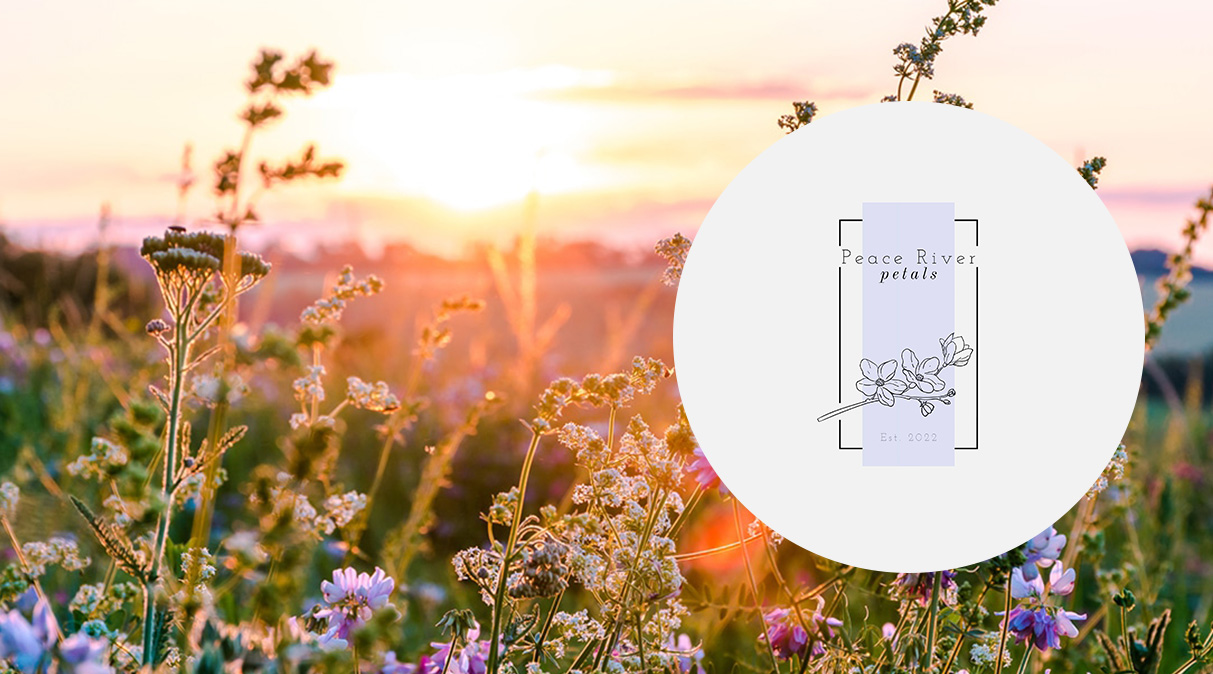Business Feature - Peace River Petals


Q&A with Owner and Operator, Shi Murphy
You want to fill the world with flowers but you’re settling for filling our gardens one-at-a-time. That is such a cool plan. Can you teach me from scratch?
Imagine this. You have an area of your yard that you feel has tons of potential but have no idea of where to start. You have to begin by observing – Sunny or shady? Waterlogged or prone to drought? Is it windy or sheltered? Do pets or children have access? Once you know these basics it is easier to identify your needs and I can offer flowers that will thrive in your space. A carefully thought out plan will have your perennials returning year after year with little to no input from you. Even some annuals will readily self-seed and return the following year.
I’ve tried my hand at gardening and had limited success. How important is it to ensure I have the right flowers for our plant zone?
When it comes to annuals (plants that complete their life cycle in 1-year) it isn’t as important to make a choice based on our zone. The heat and intensity of the sun are more than sufficient to bring most plants to life. Hardiness zones are helpful in determining if a perennial (a plant that comes back year after year) will survive our harsh winters. Depending on where you sit within Saddle Hills, the zone could be anywhere from a 2a thorough 3b. All that means is the lowest temperature of the year ranges between -45.5 to -34.5 c. Don’t be put off by the extremes – there are plenty of perennials that thrive in such conditions. One example is tulips. Back on the coast because of the warm winters, they were considered annuals. One and done. You had to replant each bulb every year to have blooms. In our harsher climate here in the north, tulips are happy in the cold and is actually helps them go through a necessary period of dormancy and re-produce blooms. Some other flowers that do well with an extended period of cold are Bee Balm, Coneflowers (such as Echinacea), Salvia, and Delphiniums. Try not to be discouraged by perceived failures in the garden. These are really opportunities for learning in disguise. Try and try again.
How important is the type of soil I use. I presume that just clearing off the layer of grass to expose a patch of dirt isn’t enough?
There will always be exceptions to the rule, but you are absolutely correct that typically isn’t enough to make plants grow. Soil is basically a mixture of organic and inorganic materials, water, air, and microorganisms. We have quite a bit of clay where we are situated and clay soil tends to hold onto water. Clay soil will waterlog the plants as their roots easily drown without access to oxygen. What I do is called lasagna gardening. Its where I layer organic materials over the clay soil, and over time it breaks down to create this beautiful black gold. The process invites all the good bugs and microorganisms who work hard to turn all the matter into soil. Using a broad fork is a wonderful alternative to tilling if you need to break up to soil a little. I personally don’t suggest tilling if you can help it as it will only bring up more weeds and that alone is discouraging to any gardener. For this reason I also love mulch. Mulch everything and your weeding time will significantly decrease. I use wood chips from our logging adventures over the past several months, but you can use physical weed barrier like landscape fabric, straw, or even fallen leaves. The latter two will add back to your soil by breaking down over time.
How do I know what kind of fertilizer to add to the soil, and how much?
The best way to identify your soil needs is to get a soil test. You can easily find them online. I recommend testing more than one area to get a good picture of your needs. Once you’ve identified what your soil needs you can amend it as needed. All plants need nitrogen, phosphorus, and potassium – typically seen as N-P-K on any fertilizing products. The numbers are shown as percentages by weight. There are many different fertilizing products sold in stores. I prefer to make my own. This is a personal preference and it may not work for everyone. By creating compost, we are able to supplement most of our nitrogen needs. We also produced quite a bit of wood ash over the winter, which adds a ton of potassium, phosphorus, and other macro-nutrients. Don’t add ash to acid loving plants as it does raise the PH of the soil. Your coffee grounds are even useful. Added to your garden soil they can provide organic material, aeration, and improve drainage. Use the grounds unrinsed to lower the PH of the soil, or rinse them to keep the PH more neutral depending on which crop you apply it to. Every plant and flower have unique needs. To find out what your garden needs will require a little research and tons of trial and error.
You made the Peace Country your home last May. How did you do with your first summer garden? Learn any lessons?
Yes! We are just coming up on our one-year of living here. My garden wasn’t a great success the first year but it offered tons of learning experiences. I wasted no time and began breaking ground as soon as the snow melted. Getting used to a growing season that was half as long as the one I just came from was a bit to adjust to. However I have to say that the extra sunshine from the super long summer days and the intensity of that sunshine made all the difference. Everything I did grow took off and produced right through September. I was able to get a small vegetable garden in and put up a makeshift greenhouse. Mid-summer the greenhouse decided to take off in a July windstorm as I hadn’t secured it the best. But this year my husband will be putting in a bigger, better greenhouse, and he promises he’ll secure it better than I secured mine.
You’ve described gardening as an activity which takes patience, determination, and an inability to give up. What advice do you have for the novice gardener who may find the prospect a bit daunting?
For anyone who is just starting off on their gardening journey I suggest to keep going even when you want to give up. The lessons that are learned through failure are invaluable. You can use those lessons to further yourself next season. Find things that give you joy growing and it will make the process that much more enjoyable.
Poppies seem to do well here. Any tips?
Poppies are another flower that are happy to be cold. You can scatter the seeds in the fall, and have early blooms the following spring. They don’t like their roots disturbed so sowing them directly outside is preferred, but if you plant them indoors just be careful to not rustle them too much when planting out. They’re finicky cut flowers but look amazing in a flower garden or mixed bed.
How important is the amount of sunlight a patch of garden receives to the success of the flowers I plant there?
Some flowers enjoy more sun that others. Sunflowers, you guessed it – love sun! So do Cosmos, Zinnias, Marigolds, and Petunias. Though because our summers can get a lot of heat, some flowers prefer a bit of shade. Impatiens, Begonias, Foxgloves and Snapdragons all appreciate a respite from the summer heat. As a rule of thumb any plant that requires full sun should have at least 6 hours of sunlight. Anything between 4-6 is partial shade and anything less than 4 is considered shade.
Same question for rainfall. We’ve had a few dry years. How do I know when to water and when to back off?
That’s a great question. Generally, when a plant is getting established the soil should be kept moist - though not sopping wet. Once the roots have grown you can back off on the watering. I put my finger in the soil and if it feels dry an inch down I give it a good watering. It is better to water deeply, less often, than it is to water less, more often. It helps the roots seek water which gets them closer to the natural water table. Using mulch is not just a great weed barrier, it’s also amazing at retaining water. During days of drought this can make all the difference in your flowers and plants surviving. Plants will tell you if they are being over or under watered. They typically droop and look altogether sad and frumpy. My best advice, use your finger and feel the soil.
If you had to pick one flower to surround yourself/your property with, what would it be?
Oh, that’s a challenging one. I have so many favourites for so many different reasons. Sunflowers are definitely up there on my list. They’re so cheerful and stand above everything else in the garden. I have an extreme fondness of any flower that presents in spikes: Hollyhocks, Larkspur, Lupine, Gladiola and Snapdragons make me happy. Bergamot and Lavender to make the bees happy. I cannot just pick just one.
How can I purchase flowers/seeds from you?
I will be at the Farmers Markets at both Bay Tree and Rycroft from June through September with flower plugs and cut-flower bouquets. I am also working on a website that will initially just have information about inventory and a schedule of my market appearances, but I have goals of expanding down the road. I also have Instagram and Facebook accounts where I will post what I am growing and other little tid-bits behind the scenes. I anticipate that I will also be using these outlets to offer flowers for sale, both cut flowers and garden plugs, starting in the near future. Follow #peaceriverpetals to stay informed.
Do you consult?
Consulting is not something I currently do. However, I would be open to considering it in the future.
When you’re not gardening, what are doing?
Since moving here we have had our hands full with renovations. If I can sneak any time, and I’m not wrist deep in dirt (which frankly I am quite often), I enjoy cooking and trying new foods. Besides that I have a creative edge and love to paint, or be outside in nature exploring the abundance around our home.
Find out more information at the Peace River Petals Business Listing
Contact Us
Saddle Hills
Junction of Hwy 49 & Secondary Hwy 725
RR1, Spirit River AB
T0H 3G0
T. 780-864-3760
Fax 780-864-3904
Toll-free 1-888-864-3760
frontdesk@saddlehills.ab.ca
Sign up to our Newsletter
Stay up to date on the Saddle Hills activities, events, programs and operations by subscribing to our eNewsletters.
